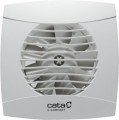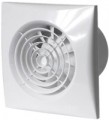Air flow (extraction)
This parameter describes the amount of air that the fan can pass through itself per hour when operating in extraction mode (see "Type"). It is one of the key characteristics of any extractor fan — it characterizes the overall performance and suitability of the unit for a particular room.
When choosing a fan for
maximum performance, two main indicators must be taken into account — the volume of the room and the air flow rate. The volume can be found by multiplying the area of the room by the height of the ceilings: for example, for a room of 12 m² in a residential apartment with standard ceilings of 2.5 m, this figure will be 12x2.5=30 m³. The air flow rate describes how many times per hour the air in an enclosed space must be completely replaced for ventilation to be sufficiently effective. This multiplicity is different for different types of premises: in particular, for the kitchen, it is 6-8, for the bathroom — 8-10, etc. More detailed values be found in specialized sources, in particular, sanitary standards. And the minimum required fan performance is calculated by multiplying the air volume by the air exchange rate. For example, if we have a bathroom with an area of 4 m² with the same ceiling of 2.5 m, then the volume of air in it will be 4x2=10 m³; Considering that the minimum air exchange rate for bathrooms is 7, for this room we need a fan with a capacity of at least 70 m³/h.
Rotational speed
The nominal fan speed during operation.
The rotational speed is one of the factors affecting the performance and, consequently, the overall efficiency of the fan. At the same time, this factor is far from being the only one. A lot also depends on the design of the blades, their number, the diameter of the impeller, etc. Therefore, fans with the same speed can differ significantly in capabilities, and you should pay attention primarily to performance.
At the same time, the rotation speed still has a certain practical significance. On the one hand, faster fans produce more noise; this drawback can be compensated to a certain extent by design tricks, but they, in turn, noticeably affect the price. On the other hand, to ensure the desired level of performance, lower-speed fans must either have impellers of a larger diameter (which accordingly affects the dimensions, and in most cases, the installation size) or, again, use design tweaks that affect the price.
Noise level
The noise level reproduced by the fan in normal operation.
The
lower the noise level, the more comfortable the use of the fan will be, the better it is suitable for rooms in which it is desirable to keep silence. In addition, there are certain regulations written in sanitary standards (for example, for residential premises during the day, a constant noise level of up to 40 dB is considered acceptable, and at night — up to 30 dB).
When choosing according to specific values recorded in the characteristics, it should be taken into account that the decibel used to measure the noise level is not a linear quantity: for example, an increase in sound power by 2 times corresponds to an increase of 3 dB, 10 times — by 10 dB, 100 times — by 20 dB. Therefore, to assess the noise level, it is easiest to refer to comparative tables, where the correspondence of specific values in decibels to various real sound sources is recorded. In most modern fans, noise is between 20 and 60 dB, here is the simplest table for this range:
20 – 25 dB — a weak audible sound, comparable to a whisper at a distance of 1 – 2 m;
25 – 30 dB — intelligible whisper at a short distance, ticking of a wall clock;
35 dB — muffled conversation;
40 – 45 dB — normal human speech;
50 – 55 dB — talking in raised tones, noise in the office;
60 dB — loud conversation at a distance of several metres.
Note that patter
...ns over 50 dB are rare; usually, these are “industrial” class units with a 400 V power supply and a large mounting diameter (see above), not intended for residential premises.Protection level
The level of protection of the fan housing (more precisely, sensitive parts located in the housing) from dust and moisture, measured by the IP standard. This standard assumes marking in the form of two numbers after the letters IP — for example, IP54. In this case, the first digit describes the level of protection against dust and other objects, and the second — from moisture.
In terms of resistance to the penetration of foreign objects in fans, the following values \u200b\u200bcan be found:
2 — protection against objects larger than 12.5 mm (enough to protect against adult fingers);
3 — from objects larger than 2.5 mm;
4 — from objects more than 1 mm (not every wire can get inside);
5 — full protection against objects; a small amount of dust may have entered the unit without any noticeable effect on performance.
In terms of water protection, options can be as follows:
4 — resistance to water splashes from any direction;
5 — resistance to water jets from any direction;
7 — the ability to endure short-term immersion in water to a depth of 1 m without consequences.
There are also higher rates of water protection. However, it does not make sense to provide them to fans. The mentioned "4" and "5" are quite sufficient for installation in bathrooms, showers and most other places where there is
...a possibility of moisture getting on the units, higher levels of protection complicate and increase the cost of the design, and there is very little practical need for them.
In some models, instead of one digit (most often the first one), there may be the letter X. This does not mean the absence of appropriate protection — it most often exists, and sometimes its degree can be quite high; we are only talking about the fact that official testing according to the IP standard was not carried out. For example, a fan marked IPX4 can be closed even from a thin wire, but if it passed official tests only for moisture resistance, the manufacturer has the right to indicate only one digit.
It is also worth noting that the complete absence of IP marking does not mean a lack of protection. However, if resistance to dust and moisture is crucial for you, you should still choose among models where this feature is officially claimed by the manufacturer.Cover height
The size of the decorative fan cover in height.
For details on the features of such panels in different types of fans, see "Cover diameter". The same size is indicated in cases where the panels are in the shape of a square or rectangle (see "Cover shape").
Cover width
The size of the decorative fan cover in width.
For details on the features of such panels in different types of fans, see "Cover diameter". The same size is indicated in cases where the panels are in the shape of a square or rectangle (see "Cover shape").
Cover thickness
The size of the decorative fan cover in thickness.
This parameter describes how much such a panel protrudes above the surface of the wall or ceiling on which the fan is installed. For more information about the general features of decorative panels in different types of fans, see "Cover diameter".
Cover material
Manufacturers are actively innovating in the design of this part of the device. First of all, it is worth highlighting the various materials of execution, each of which has its advantages. And in particular, cheaper, but
plastic covers of various shapes, stylish and strict
metal covers, elegant and sophisticated
glass covers(
plexiglass is also found) and, of course, exclusive
wooden ones. More details about each:
— Plastic. Plastic covers are easy to process at the production stage and are inexpensive. At the same time, plastic is quite durable and practical. Such surfaces can be given almost any shade and colouring, due to which there is a wide variability of exhaust fans with a plastic cover. The disadvantages of this material include perhaps relatively low strength and sensitivity to scratches. However, such problems are rarely encountered due to the peculiarities of the placement of extractor fans.
— Stainless steel. Stainless steel is a high-strength material that resists scratches and looks stylish and rich. The stainless steel covers increase the reliability of the extractor fan housing and allow it to harmoniously fit into a modern interior. There are design options as a solid sheet of stainless steel and panels with decorative perforations. Metal covers are usually expensive,
...so there are relatively few such models. The vast majority of them belong to the premium class and are intended for interiors of the appropriate level.
— Glass. Glass covers are a design highlight of the design of extractor fans. This material is easy to clean and does not give in to scratches, has a shiny gloss or has a discreet matte structure. Glass covers in extract fans can be painted in a variety of colours, which allows you to choose the right model for the interior design concept of the room. Glasses for the front panel are often made tempered — there is no need to worry about the fragility of this material.
- Wood. Quite a rare material for exclusively decorative purposes. Such covers are harmoniously combined with interiors in a certain style — for example, with wooden walls, rooms in an "eco" design, baths or saunas. However, from a practical point of view, they do not have advantages over the same plastic ones but are noticeably more expensive. Today, wooden covers are rather exotic, designed for principled adherents of natural materials.
- Plexiglas. A more advanced and durable analogue of plastic. Plexiglas usually have a translucent glossy finish with a characteristic sheen in the light. As a rule, such panels are made monophonic. They best fit in with the minimalist interiors of the premises. This option can be found in models of a strong middle level and top class.
— Aluminium. This material can be attributed to a confident middle class: aluminium is lightweight, has high strength, and is characterized by durability and resistance to corrosion. In addition, aluminium can be easily polished at the production stage, which simplifies the manufacturing process of aluminium covers. Extractor fans with such a front panel look stylish and expensive.Mounting depth (duct)
Mounting depth of the fan with a standard installation method.
This parameter describes how deep into the duct the unit (or its parts in the case of surface-mounted models, see "Type") is placed during installation. Knowing the mounting depth, it is possible to assess the suitability of the selected model for a particular installation location: a flat section at the very beginning of the duct must be no less than the installation depth of the selected fan.
The smallest value of this parameter is typical for some overhead models of fans: in them, the main part of the structure is outside, and usually, only 2-3 centimetres are required for installation. And most of all, hidden units require space (see "Type").

